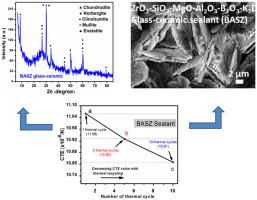Materials Today Energy ( IF 9.0 ) Pub Date : 2020-10-22 , DOI: 10.1016/j.mtener.2020.100535 Mrinmoy Garai , Basudeb Karmakar

|
This work illustrates the strong effects of Ti4+ and Zr4+ (M4+) on nucleation ability of SiO2-MgO-Al2O3-B2O3-K2O-F glass-ceramic sealant. An addition of such 5 wt.% M4+ content caused a slight increase in density value (2.60–2.61 g.cm−3). X-ray diffraction (XRD) experiment revealed no indication of any crystallinity in melt-quenched glass-sealant and that was further confirmed from transmission electron microscopy. XRD established the development of multicrystalline phases in investigated glass-sealants at solid oxide fuel cell (SOFC) operation temperature (=800 °C). The reflected XRD peaks on the heat-treated (i.e., 800 °C) SiO2-MgO-Al2O3-B2O3-K2O-F glasses were indexed as norbergite (Mg2SiO4.MgF2), humite [Mg7F2(SiO4)3], chondrodite [Mg5F2(SiO4)2], mullite (3Al2O3·2SiO2) and enstatite (MgSiO3) phases. Field-emission scanning electron microscope (FESEM) experiment indicated that the plate-like crystallite particles (size 3–10 μm) were precipitated in a mother glass matrix heated at 800 °C and restructured into droplet-type morphology when nucleation was supported by Ti4+ ions. The presence of Zr4+ ion results an interlocked type microstructure that is desirable for sealing application because of their capability to resist the growth of a microcrack caused due to thermal stress. A wide thermal expansion value (=11.06 × 10−6/K) compatible with SOFC components (electrode, electrolyte, interconnect, and so on) is achieved for Zr4+-doped SiO2-MgO-Al2O3-B2O3-K2O-F glass-ceramic. No considerable deformation in thermal expansion value up to 10 thermal cycling operations is obtained for Zr4+ doped glass and this is ascribed to the interlocked type morphology (FESEM).
中文翻译:

Si-Mg-Al-KBF玻璃陶瓷密封胶(固体氧化物燃料电池)中Zr +4控制的成核和微观结构
这项工作说明了Ti 4+和Zr 4+(M 4+)对SiO 2 -MgO-Al 2 O 3 -B 2 O 3 -K 2 O-F玻璃陶瓷密封胶的成核能力的强大影响。添加这样的5 wt。%M 4+含量会导致密度值略有增加(2.60–2.61 g.cm -3)。X射线衍射(XRD)实验表明,在熔融淬火的玻璃密封剂中没有任何结晶迹象,这已由透射电子显微镜进一步证实。XRD建立了固态氧化物燃料电池(SOFC)工作温度(= 800°C)下的玻璃密封剂中多晶相的开发。在经过热处理(即800°C)的SiO 2 -MgO-Al 2 O 3 -B 2 O 3 -K 2 O-F玻璃上反射的XRD峰被标记为水钠钙石(Mg 2 SiO 4 .MgF 2) [Mg 7 F 2(SiO 4)3],长方晶石[Mg 5 F 2(SiO 4)2 ],莫来石(3Al 2 O 3 ·2SiO 2)和顽辉石(MgSiO 3)相。场发射扫描电子显微镜(FESEM)实验表明,板状微晶颗粒(尺寸3–10μm)在加热至800°C的母玻璃基质中沉淀,并在Ti支撑成核时重组为液滴型形态。4+离子。Zr 4+的存在离子产生互锁型微结构,这对于密封应用是理想的,因为它们具有抵抗由于热应力引起的微裂纹生长的能力。对于Zr 4+掺杂的SiO 2 -MgO-Al 2 O 3 -B 2,可以实现与SOFC组件(电极,电解质,互连等)兼容的宽热膨胀值(= 11.06×10 -6 / K)。O 3 -K 2 O-F玻璃陶瓷。对于掺杂Zr 4+的玻璃,在进行多达10次热循环操作时,没有获得明显的热膨胀变形,这归因于互锁型形态(FESEM)。











































 京公网安备 11010802027423号
京公网安备 11010802027423号